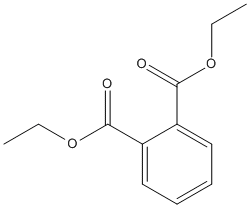Diethyl-phthalate
General
Type : Aryl ester || Phthalate
Chemical_Nomenclature : diethyl benzene-1,2-dicarboxylate
Canonical SMILES : CCOC(=O)C1=CC=CC=C1C(=O)OCC
InChI : InChI=1S\/C12H14O4\/c1-3-15-11(13)9-7-5-6-8-10(9)12(14)16-4-2\/h5-8H,3-4H2,1-2H3
InChIKey : FLKPEMZONWLCSK-UHFFFAOYSA-N
Other name(s) : Diethyl phthalate, Phthalic acid diethyl ester, Ethyl phthalate, Anozol, Neantine, DEP

Target
Families : Hormone-sensitive_lipase_like, Carb_B_Bacteria
References (7)
| Title : Structural Insights into (Tere)phthalate-Ester Hydrolysis by a Carboxylesterase and Its Role in Promoting PET Depolymerization - von Haugwitz_2022_ACS.Catal_12_15259 |
| Author(s) : von Haugwitz G , Han X , Pfaff L , Li Q , Wei H , Gao J , Methling K , Ao Y , Brack Y , Jan Mican J , Feiler CG , Weiss MS , Bednar D , Palm GJ , Lalk M , Lammers M , Damborsky J , Weber G , Liu W , Bornscheuer UT , Wei R |
| Ref : ACS Catal , 12 :15259 , 2022 |
| Abstract : von Haugwitz_2022_ACS.Catal_12_15259 |
| ESTHER : von Haugwitz_2022_ACS.Catal_12_15259 |
| PubMedSearch : von Haugwitz_2022_ACS.Catal_12_15259 |
| PubMedID: 36570084 |
| Gene_locus related to this paper: thefu-1831 |
| Title : Characterization of XtjR8: A novel esterase with phthalate-hydrolyzing activity from a metagenomic library of lotus pond sludge - Qiu_2020_Int.J.Biol.Macromol_164_1510 |
| Author(s) : Qiu J , Yang H , Yan Z , Shi Y , Zou D , Ding L , Shao Y , Li L , Khan U , Sun S , Xin Z |
| Ref : Int J Biol Macromol , 164 :1510 , 2020 |
| Abstract : Qiu_2020_Int.J.Biol.Macromol_164_1510 |
| ESTHER : Qiu_2020_Int.J.Biol.Macromol_164_1510 |
| PubMedSearch : Qiu_2020_Int.J.Biol.Macromol_164_1510 |
| PubMedID: 32755708 |
| Gene_locus related to this paper: 9zzzz-XtjR8 |
| Title : Identification and characterization of a novel phthalate-degrading hydrolase from a soil metagenomic library - Qiu_2020_Ecotoxicol.Environ.Saf_190_110148 |
| Author(s) : Qiu J , Zhang Y , Shi Y , Jiang J , Wu S , Li L , Shao Y , Xin Z |
| Ref : Ecotoxicology & Environmental Safety , 190 :110148 , 2020 |
| Abstract : Qiu_2020_Ecotoxicol.Environ.Saf_190_110148 |
| ESTHER : Qiu_2020_Ecotoxicol.Environ.Saf_190_110148 |
| PubMedSearch : Qiu_2020_Ecotoxicol.Environ.Saf_190_110148 |
| PubMedID: 31911388 |
| Gene_locus related to this paper: 9zzzz-EstJ6 |
| Title : Biodegradation of phthalate esters by Paracoccus kondratievae BJQ0001 isolated from Jiuqu (Baijiu fermentation starter) and identification of the ester bond hydrolysis enzyme - Xu_2020_Environ.Pollut_263_114506 |
| Author(s) : Xu Y , Minhazul K , Wang X , Liu X , Li X , Meng Q , Li H , Zhang C , Sun X , Sun B |
| Ref : Environ Pollut , 263 :114506 , 2020 |
| Abstract : Xu_2020_Environ.Pollut_263_114506 |
| ESTHER : Xu_2020_Environ.Pollut_263_114506 |
| PubMedSearch : Xu_2020_Environ.Pollut_263_114506 |
| PubMedID: 32268225 |
| Gene_locus related to this paper: 9rhob-a0a5p8jcg2 , 9rhob-a0a5p8jaa4 |
| Title : Assessment of phthalate ester residues and distribution patterns in Baijiu raw materials and Baijiu - Dong_2019_Food.Chem_283_508 |
| Author(s) : Dong W , Guo R , Sun X , Li H , Zhao M , Zheng F , Sun J , Huang M , Wu J |
| Ref : Food Chem , 283 :508 , 2019 |
| Abstract : Dong_2019_Food.Chem_283_508 |
| ESTHER : Dong_2019_Food.Chem_283_508 |
| PubMedSearch : Dong_2019_Food.Chem_283_508 |
| PubMedID: 30722905 |
| Title : [Metabolism of dibutyl and diethyl phthalates in the rat] - |
| Author(s) : Chambon P , Riotte M , Daudon M , Chambon-Mougenot R , Bringuier J |
| Ref : C R Acad Hebd Seances Acad Sci D , 273 :2165 , 1971 |
| PubMedID: 5003086 |